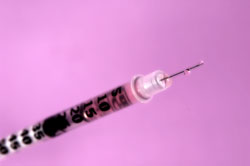 Botulinum toxin, otherwise known as Botox, is being used by some medical professionals to do more than just smooth the appearance of wrinkles. The chemical inhibits the release of acetylcholine (ACh), an ion in the nervous system that increases skeletal muscle activity. Some scientists who have studied trigger points of chronic pain have suggested that symptoms of pain may be related to an excessive release of ACh that blocks neurotransmitters. Various studies have tested the theory that Botox may help decrease ACh and ease pain in the neck and back. Thus far, the results of these studies have been contradictory.
Botulinum toxin, otherwise known as Botox, is being used by some medical professionals to do more than just smooth the appearance of wrinkles. The chemical inhibits the release of acetylcholine (ACh), an ion in the nervous system that increases skeletal muscle activity. Some scientists who have studied trigger points of chronic pain have suggested that symptoms of pain may be related to an excessive release of ACh that blocks neurotransmitters. Various studies have tested the theory that Botox may help decrease ACh and ease pain in the neck and back. Thus far, the results of these studies have been contradictory.
In an analysis of the use of Botox to treat neck and back pain, researchers in Spain looked at the variables involved in previous studies and sought to explain the differences in the results.
Several factors varied in the previous research. The study authors concluded that due to the contradictory results of the effectiveness of Botox injections to treat neck and back pain, the method could be neither recommended nor rejected.
In another study, researchers in Egypt tested the effectiveness of injecting Botox into the muscle attached to the temporomandibular joint (TMJ) to treat painful jaw clicking. In this study, participants were injected with Botox and assessed for a four-month period that included an MRI analysis at the end of this period. While an initial decrease in TMJ clicking and an improvement in disc position was evident, the researchers found the effect to be short-term, with Botox offering insignificant results four months after the injections.
In contrast, former research has shown chiropractic care to give long-term relief to those suffering from dysfunction of the TMJ.
And treatment by a chiropractor has been shown to consistently relieve a host of other ailments, including chronic pain in the back and neck.
Reference
Climent J, et al. Botulinum toxin for the treatment of myofascial pain syndromes involving the neck and back: a review from a clinical perspective. Evidence-Based Complementary and Alternative Medicine 2013; doi: 10.1155/2013/381459.
Emara S, et al. Botulinum toxin injection for management of temporomandibular joint clicking. International Journal of Oral and Maxillofacial Surgery 2013; doi: 10.1016/j.ijom.2013.02.009. [Epub ahead of print].